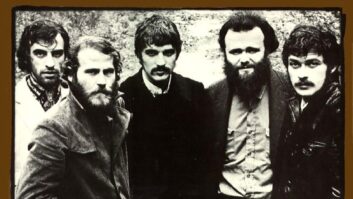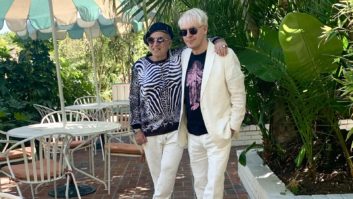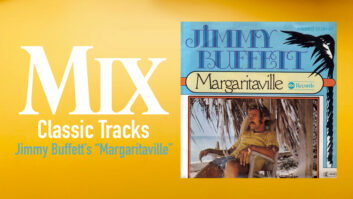 When George McCrae’s smash hit “Rock Your Baby” hit Number One in mid-1974, few could have predicted that it would usher in the Age of Disco. Listening to the song today, it seems so low-key and innocent. Catchy, yes, and there was that metronomic thump-thump beat and the percussive accents that got the heart racing, but how could something so simple lead to the greatest commercial music craze of the ’70s, not to mention the vociferous Disco Sucks backlash? We’ll leave that analysis to the sociologists. This is a story about the early days of the disco phenomenon, and one of the people at the center of it all, Harry Wayne Casey, the “KC” of KC & the Sunshine Band fame.
When George McCrae’s smash hit “Rock Your Baby” hit Number One in mid-1974, few could have predicted that it would usher in the Age of Disco. Listening to the song today, it seems so low-key and innocent. Catchy, yes, and there was that metronomic thump-thump beat and the percussive accents that got the heart racing, but how could something so simple lead to the greatest commercial music craze of the ’70s, not to mention the vociferous Disco Sucks backlash? We’ll leave that analysis to the sociologists. This is a story about the early days of the disco phenomenon, and one of the people at the center of it all, Harry Wayne Casey, the “KC” of KC & the Sunshine Band fame.
Born in Hialeah, Fla. (outside of Miami), in 1951, Casey was drawn to music at an early age, becoming an accomplished keyboard player by his late teens. Working for the local Tone Distributors, he learned about record retailing and distribution and also began working (for free) in the company’s studio. There he met a young bassist and engineer named Richard Finch who, in 1973, became his writing partner and bandmate. “Miami was a happy place to grow up and listen to music,” Casey told me recently. “There’s an energy down here-Miami has always been special. We get music here that no one else in the country plays. There are always hits here that no one else touches. Miami has always loved uptempo things, dance music; a lot of variety. It’s a happy environment. The beach, the late-night clubs, all the different cultures coming together-all those things affected the music we made when we were starting out.”
In the beginning it was KC & the Sunshine Junkanoo Band that cut records for Henry Stone’s local TK Records label. Junkanoo was a percussion-oriented pop dance music with roots in the Bahamas, one of many styles that popped up in local clubs. “We were a rhythm and blues band and we played almost exclusively in black clubs,” Casey, who is white, remembers. “One time I went to this wedding and heard a junkanoo band there and people were blowing these whistles and there was this great beat going and I remember thinking, ‘If I could capture this on record this could really be something; a new sound.’ So on the plane I wrote ‘Blow Your Whistle’ and I went into the studio and started putting together this junkanoo band. The original idea was to have that as part of all the records we made at the studio [TK Studios in Hialeah]. I can’t remember why, but we didn’t end up using the junkanoo guys much after our first record. Maybe it was too hard to track ’em down every time, or something. So we dropped ‘Junkanoo’ from our name and became KC & the Sunshine Band.” “Blow Your Whistle” was the group’s first U.S. hit single and a club favorite in Britain, as well.
Initially KC & the Sunshine Band was primarily a studio group, a highly talented interracial unit that became the house band for TK Records. In fact, “Rock Your Baby” was written by Casey and Finch and began its studio life as a KC & the Sunshine Band song demo. “We took it to Henry [Stone] to get approval to record it, and he said, ‘It’s fine like it is; we just need to get a singer,'” Casey recalls. “George McCrae walked in the door, I hummed him the melody and he liked it, so we ran upstairs and put his voice on it.” Casey and Finch shared production chores, and the track topped both the American and British charts.
Casey and Finch went on to write and record more hit tunes for McCrae and for fellow Miamian Betty Wright but spent increasing amounts of time working with the Sunshine Band at TK Studios, a 16-track room that Casey says was “tiny; you could barely fit a group in there. But it was comfortable for us, and Rick [Finch] really knew his way around it.”
The studio did have its limitations however, so Casey and Finch enlisted the aid of engineer Milan Bogdan (who, though still young, already had plenty of studio experience in his native Detroit, in Atlanta and Muscle Shoals) to help iron out some technical problems they were having at TK and to help them design and build a new studio in Hialeah-Sunshine Sound. That studio was quite an improvement over TK: It featured two rooms equipped with MCI consoles and 24-track recorders-an Ampex 1200 in one room, and an MCI 528 in the other. “The early MCI stuff was great,” Bogdan says. “We modified the console and had transformerless mic pre’s and built our own little current amplifiers. Since MCI was just down the road [in Miami], I could go in the back door and bring my modules and get parts and have them fixed. Sunshine Sound was a nice studio. We had a rehearsal hall that had a 24-foot ceiling in it with lights and mirrors. We had Sony 31/44-inch video decks in there and Sony color cameras, so the band could rehearse in there. They used to play every single day. We could work on live mixes and monitors, and the lighting guy could work on lights while the band rehearsed. We had a little shop in the back where we worked on gear for the road. We did the mastering there; we had a Scully lathe. We had everything we needed.”
In a burst of songwriting work toward the end of 1974, Casey and Finch penned a number of the tunes that would, the following year, propel KC & the Sunshine Band to international stardom, including “Get Down Tonight” and “That’s the Way (I Like It).” Of the latter tune, Casey comments, “I remember I came up with part of it in the shower and some of it driving to and from the studio. It wasn’t meant to be anything but a love song; it was nothing serious. It’s real simple. I wanted something that people would remember and that would be easy to dance to.
“See, I’d worked at retail and people would come in and ask for a record and a lot of time they wouldn’t know the name of it. They might know a couple of words in the chorus. And I thought, ‘Well, people are going to know the name of my records!’ Then I got to thinking about some of the songs I was writing as being too repetitious, but I looked at this Beatles record and it had ‘She loves you, yeah, yeah, yeah/She loves you, yeah, yeah, yeah,’ and I realized I was probably on the right track.” The early versions of “That’s the Way (I Like It)” were considerably more risque than what finally came out on the record-Casey says the “uh-huh’s,” as sung by female backup singers Jeanette Williams and Beverly Champion “were a lot like the sound of people making love, but I was afraid it might not fly on radio, so we changed it.”
Bogdan says that in the months before Sunshine Sound was completed, a core group of Casey, Finch, guitarist Jerome Smith, drummer Robert Johnson and, occasionally, Cuban-born percussionist Fermin Goytisolo, would work up live basics an 8-track version of Casey and Finch’s tunes at Casey’s house using a TEAC 8-track deck. Then, they would either re-cut at TK or, if the band had trouble matching the feel of the demo, dump the 8-tracks over onto a 16-track and build from there, adding percussion, vocals and sometimes horns.
In the case of both “That’s the Way (I Like It)” and “Get Down Tonight,” Casey says, “We recorded the original 8-tracks at TK and then we went to Criteria to do the horns and my vocals because we needed more tracks. Around that time, TK built another, bigger studio next door to the old studio, and we did some work on ‘That’s The Way (I Like It)’ and ‘Boogie Shoes’ in that studio-a lot of percussion work and some vocals. Then we started building our studios and our entire third album was done there, with ‘Shake Your Booty,’ ‘I’m Your Boogie Man’ and ‘Keep It Comin Love.’ By then, of course, we had every piece of equipment known to man.”
In Bogdan’s memory, Sunshine Sound was operational by the time the single of “That’s the Way (I Like It)” was mixed, though no tracking on the song was done there. In early 1975, KC & the Sunshine Band toured Europe to capitalize on their numerous chart successes there, and while they were in Britain “Get Down Tonight” became a breakaway hit for the group, eventually hitting Number One in the U.S. the week the group returned to Miami. “They were pretty shocked when they got back,” Bogdan says. “It was great. Everybody had worked really hard. It gave everybody a new level of confidence because what they were doing was suddenly being accepted.” The momentum continued building through the summer and fall: The group toured the U.S. drawing sold-out houses, their eponymous album, released in August, made it to Number 4, and in November, “That’s the Way (I Like It)” rocketed to Number One in the U.S and Britain.
“For a while there it seemed like every time I’d turn on the radio they’d be playing KC & the Sunshine Band or some group that sounded just like them,” Bogdan says. “We heard the influence of the music everywhere, especially the percussion ideas. Rick and KC are the ones who came up with those ideas, all those cymbal parts, and figuring out ways for the percussion to fill in the holes between the beats.” Casey also credits drummer Robert Johnson for being “just impeccable.” In this era before drum machines and sequencers, Johnson kept perfect disco time take after take, and onstage.
When Sunshine Sound was completed, that facility became the focus of the group’s efforts. Usually KC & the Sunshine Band occupied the big pyramid-shaped studio (“We were into pyramid power at the time,” Bogdan says with a laugh), and the other room would be used for outside projects Casey and Finch were involved with. “It was a good room for drums, and that was always a key thing when we were recording,” Bogdan says. “We spent a lot of time changing heads and making sure the snare drums were perfectly flat. We might spend all day working on one snare drum-listen to it, take it to the shop, work on it. We might use four or five snare drums in a day. If you wanted a good, crisp snare with a lot of low end, it took a lot of time make that happen. Sometimes we’d have the tom heads on and sometimes they were off. We’d usually mic the top and bottom of all the drums, flip it out of phase. Usually we’d have dynamics on the snare; overheads were usually some type of Neumann or AKG tube mics. At Sunshine Sound we also had a long trap, like a chamber, in the ceiling that the bass amp [sound] would slide into, and we’d mic it way up there. We were always trying new things.”
Casey says that during the peak years of his group, “We would achieve this amazing oneness in the studio. We’d get in there and things would immediately lock in; there was no stopping it. We kept things kind of loose, but at the same time controlled. I’ve never experienced anything quite like it, before or since, with a group.”
KC & the Sunshine Band had an impressive chart run throughout the second half of the ’70s, as disco swept the world. Their “Boogie Shoes” was included on the gazillion-selling soundtrack for Saturday Night Fever, giving them perhaps their largest worldwide exposure. By 1979, however, Casey was trying to move in some new directions, away from disco. “Do You Wanna Go Party” was more a retro funk piece, and the group’s final Number One, “Please Don’t Go” was a ballad. Following that hit, TK Records went bankrupt, and the group was in limbo for a while. Eventually they disbanded, and Casey signed a solo deal with Epic. In 1982 he was seriously injured in an automobile accident and then later he retired for eight years. “But I kept having people asking me, ‘How come you’re not making music?'” he says. “Basically, people pushed me back into music. And now I’m having a great time. They can’t give me enough dates.”
Indeed, the ’90s version of KC & the Sunshine Band (which includes original percussionist Fermin Goytisolo and singer Beverly Champion) tours successfully all around the world. Tracks by the band appear on countless disco and ’70s compilations, and the group’s own CDs sell briskly year-in year-out. “I think people are attracted to the old sound,” Casey muses. “The ’70s were the last decade of real music made by real instruments, before computers came in. It makes me feel good that people still want to hear this music and dance to this music. Evidently there was some substance to it. And it’s still influencing people today.”







